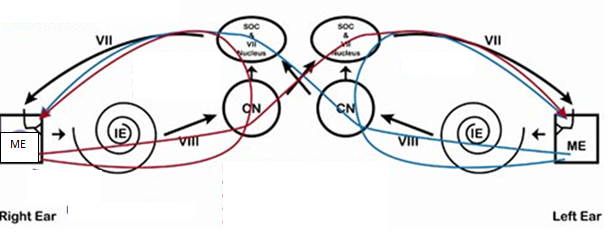Your Audiology Tutorial: Acoustic Reflexes
The stapedius muscle inserts on the stapes bone, one of three in the ossicular chain attached to the eardrum. This muscle will contract when an acoustic signal of a certain intensity and duration is presented. The acoustic reflex is a measurement of the contraction of the stapedius muscle to give information about the pathway that travels from the middle ear space and back, either to the same (ipsilateral) or opposite (contralateral) ear. Along the way, the inner ear, cochlear nucleus, and other structures of the auditory pathway are traveled by the stimulus. "Up the eighth nerve, and down the seventh nerve", to put it crudely.
A threshold for several pitches (usually 500 - 4000 Hz) is obtained by presenting tones as low as 80 dB HL and as loud as 110 dB HL, which, relative to a patient's pure tone averages obtained during a behavioral audiometric evaluation, may be considered "normal", "elevated" or not present at all ("No Response"). As with audiometry, the clinician is trying to find the lowest level at which the physiological response is present. For a patient with hearing sensitivity within normal limits, the acoustic reflex threshold (ART) is usually between 70 to 80 dB higher than the thresholds measured during pure tone audiometry. Patients with sensorineural hearing loss may have normal to elevated responses.
Acoustic reflexes can be used as a cross check for other diagnostics, or as a means to estimate hearing sensitivity in those for whom behavioral testing is not possible or reliable. Differential diagnosis is helped along by this generally quick test (which requires an acoustic seal of the tympanic membrane, obtained with a rubber probe placed at the aperture of the ear canal). When the middle ear is compromised by otitis media (fluid), ARTs may be absent both in the ipsilateral and contralateral ears. Facial nerve paralysis, vestibular schwannomas, and other conditions will show distinctive arcs and patterns that can assist a clinician in his or her assessments and reports. I had an adjunct professor in graduate school who was adamant about the use of acoustic reflexes in the clinic. "It's like a mini ABR (Auditory Brainstem Response)!" he exclaimed.
Due to the loud levels that may need to be presented, caution should be exercised in performing acoustic reflexes on patients with tinnitus and/or hyperacusis.



Comments